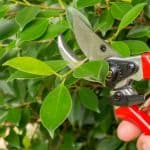Last updated on March 14th, 2022
Our site is reader supported, this means we may earn a small commission from Amazon and other affiliates when you buy through links on our site.
Rubber plants are wonderful plants to have in your home, office, practically any warm indoor space. It is from these plants that we derive the sap needed to create rubber, but rest assured you won’t have to contend with that if you are cultivating them in your home because that production does not begin until the plants have reached full maturity, which when grown has houseplants it hardly ever reaches. At the end of the day, rubber plants can reach huge sizes and they are actually a tree. That being said, they make excellent houseplants and the size and shape can easily be controlled, and we think every home should have one.
Growing Rubber Plants
Rubber tree plants are part of the Ficus group and if you are growing them indoors it is important that you pick a younger plant rather than a mature plant. Younger plants will have an easier time adapting to indoor conditions and in the UK you can’t really grow them outdoors anyway.
Rubber trees, when used as houseplants, need an indirect bright light but can handle a couple of hours of morning sun. We recommend that you put them near a window so they get plenty of light but not direct light because this can scorch and damage the leaves. At the end of the day, you’re trying to mimic their natural environment.
Planting
Planting rubber trees should be done with considerations for how large the plant will be at full maturity. It is best to provide it with adequate space so that you don’t need to keep repotting it further down the line. They prefer a good quality potting compost, any houseplant compost should be fine, and they should be positioned so they don’t get cold drafts, and in winter the temperatures should go no lower than 12°C. Finally, you can mist the leaves during the summer to increase the humidity and wash down the leaves with a damp cloth to keep the leaves nice and glossy.
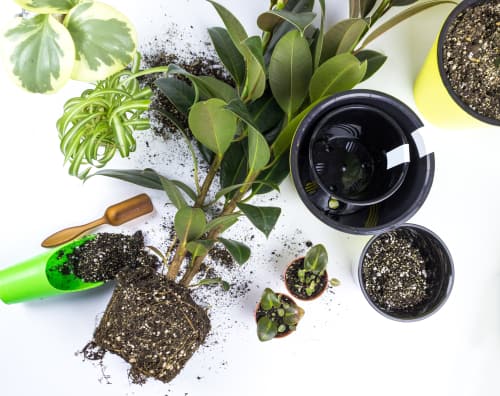
Feeding and Watering
Rubber tree plants need a properly maintained balance of water and they do suffer from overwatering, which is something to look out for because it can rot the roots. When they are growing they need moist soil. If you water them too much the leaves will end up yellow or brown and eventually fall off. To be on the safe side, we recommend only watering them when the soil has become dry to the touch, then give it a good watering. When the plant is in its dormancy you should only water once or twice per month.
If you notice the leaves are starting to droop or wilt, you can increase the water gradually until the leaves are back to normal. You can add a fertiliser regimen as necessary but it’s not a requirement and they often thrive without and when almost neglected. If you choose to feed it, apply a mixture every month to the tree during its active growing season, which is usually late spring through summer.
Propagation – Taking Cuttings and Air Layering
To propagate a rubber tree from an already successful tree you can use one of two methods. The first is to take a cutting and propagate in a small container, the same as you would almost any other plant, and the second is to use a method where you allow the cutting in question to form the root system while it is still somewhat attached to the main plant before you remove it and transplant it. This is known as air layering and we talk about it in more detail in this article here.
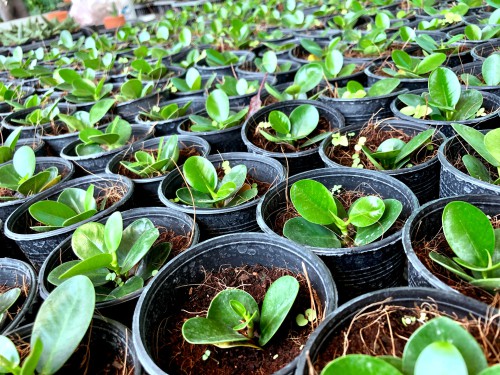
Taking cuttings
For the first method of propagation, you want to take properly sanitised pruners and select cuttings that are approximately 20-30cm in length with at least two sets of leaves. From there you want to remove any excess leaves so that you have a clear stem to plant.
This stem should be dipped in rooting hormone to help it establish itself sooner and then placed directly into a container with the proper potting mixture. There are different containers you can use for this, such as cups, jars, small pots or propagation containers. Regardless of what you use, the idea is to create a tiny greenhouse by covering the container with a plastic lid, clear glass mason jar, or plastic bag.
Whatever item you use, should not come into contact with the remaining leaves at the top of the cutting. The cuttings should be placed inside a warm area with indirect light and after approximately two or three weeks the root system should have established itself sufficiently that you can transplant.
Air Layering
The other option is to use is air propagation. With this, you selectively create a cutting that is at least 30cm in length, and while you leave it attached to the rubber plant, you strip away approximately 3cm of the outer bark, leaving nothing but the solid hardwood in the centre. You want to place moist moss around this exposed hardwood and cover it with plastic so that it retains its moisture. Again after about 3 weeks, the cutting should establish a root system that will be visible when you remove the moss and at that point, you can cut it off of the original plant and transplant it into its own pot.
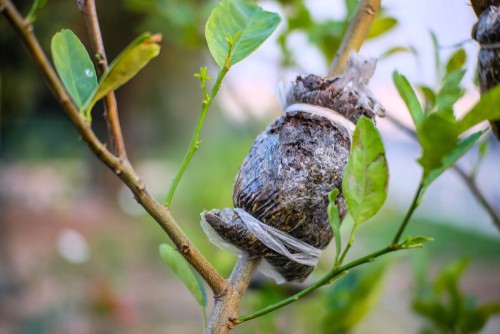
Pruning and Repotting
With rubber plants, you do need to prune them to keep the plants in check. Rubber plants can grow particularly large and in their natural environment, they can reach an impressive 10 metres tall quite easily. Most people don’t have that much space in their home, especially if they are growing them indoors so, annual pruning can be done to contain not only the height but the shape of the tree.
With rubber trees, if they are allowed to grow too large, especially when grown in containers or in smaller areas in your home, they can reach a point where the branches are unable to fully support their weight, and this results in branches snapping, which is what we want to avoid for obvious reasons.
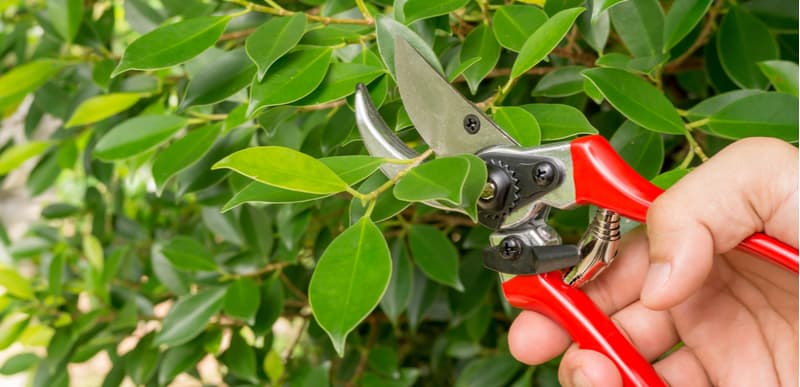
The first thing to note is that you can prune at any time of year if necessary, so if it’s much too large now, give it a good pruning. However, the plant will spring back the quickest if you prune during the spring. The end of spring or the beginning of summer, around the month of June, is the optimum time to plan your yearly pruning schedule. To do this, simply take a good sharp pair of pruning shears and make the cuts when and where you see fit. The plant will grow back from the node below, so if you cut directly above nodes you can contain the shape.
We recommend that you wear gloves because the sap can irritate your skin, especially if you have sensitive skin. If you take cuttings during your month of pruning you can repot them very effectively. You can also repot existing plants, although it is inadvisable once the plant has established itself. Of course in some situations, it simply can’t be avoided because the rubber plant has outgrown the container in which it was originally planted, in which case you can repot, the same as you would any other plant.
Problems
Common problems faced by Rubber plants include over-watering because they do not like to stand in water. If you water them too much and the soil becomes waterlogged, certain fungal pathogens can result in root rot. You know when your plant is facing root rot because the leaves turn yellow. Other than that there are very few diseases or pests you have to worry about. In regards to watering during the growing season, water well once the soil is dry to touch and water much less in winter.
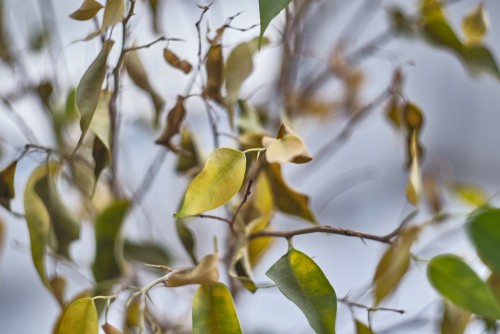
Image credits – Shutterstock.com

